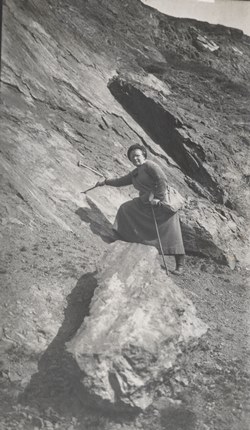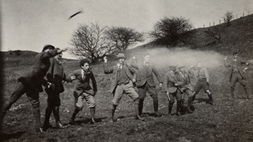Douglas Palmer on the Sedgwick Museum’s collection of ‘the simplest scientific instruments’.
 Arguably, the geological hammer is by far the oldest professional tool. And surprising as it may seem, the first to use them were our extinct hominin relatives, living on the western shore of Lake Turkana, Kenya in early Pliocene times, around 3.3 million years ago. Recent discoveries of stone artefacts1 show that these ‘proto-geologists’ were already smart enough and had sufficient experience of rock materials - their hardness and fracture properties - to be selective in their choice of rock tools. They apparently preferred basalt and phonolite cobbles and knapped them on stone anvils with stone hammers to produce sharp-edged stone flakes. What exactly these flake tools were used for is unknown, but current thinking suggests that it may have been for cutting tough plant materials. Such well-developed cognitive abilities suggest that stone-tool use with rocky hammers, originated some considerable time before this.
Arguably, the geological hammer is by far the oldest professional tool. And surprising as it may seem, the first to use them were our extinct hominin relatives, living on the western shore of Lake Turkana, Kenya in early Pliocene times, around 3.3 million years ago. Recent discoveries of stone artefacts1 show that these ‘proto-geologists’ were already smart enough and had sufficient experience of rock materials - their hardness and fracture properties - to be selective in their choice of rock tools. They apparently preferred basalt and phonolite cobbles and knapped them on stone anvils with stone hammers to produce sharp-edged stone flakes. What exactly these flake tools were used for is unknown, but current thinking suggests that it may have been for cutting tough plant materials. Such well-developed cognitive abilities suggest that stone-tool use with rocky hammers, originated some considerable time before this.
Picture: Hammer, as carried by Sedgwick in Onslow Ford’s bronze of the great man - although the handle was shortened in the statue.
Over 3.29 million years later, the geological hammer has evolved from one made of rock into a metal-headed tool; but is still used in the same basic way - albeit with a different purpose in mind. From mediaeval times, hammers diverged into a multitude of forms adapted for an increasing number of trade specialisations from the blacksmith, mason and carpenter to the jeweller, upholsterer and geologist. By the 19th Century Sheffield trade catalogues advertised around 80 different kinds of hammer.
Collection
The Sedgwick Museum has a unique collection of geological hammers. It was originally assembled by Thomas McKenny Hughes (1832-1917), who succeeded Adam Sedgwick (1785-1873) as Woodwardian Professor of Geology in the University of Cambridge in 1873 and continues to be added to today. The collection of 41 hammers, includes those belonging to some of the pre-eminent geologists of the 19th Century, such as William Buckland (1784-1856), William Daniel Conybeare (1787-1857) and Adam Sedgwick, as well as more recent Cambridge geologists such as Alfred Harker (1859-1939), G L ‘Gertie’ Elles (1872-1960), Oliver Bulman (1902-1974), H B ‘Harry’ Whittington (1916-2010) and R B ‘Barrie’ Rickards (1938-2009).
A newly published booklet (Tools of the Trade, Palmer, D 2016 – see Books & Arts), outlines the history of the geological hammer from the emergence of geology as a modern science, when pioneers, such as Robert Hooke (1635-1703) and John Woodward (1667-1728), emphasized field observation and collecting as an essential route to understanding Earth’s processes, products and history. In 1665, Hooke refers to the use of a hammer in collecting fossils: ‘That these Shells…have in tract of time rotted and mouldred away, and only left their impressions both on the containing and contained substances; and so left them pretty loose… so that they may be easily separated by a knock or two of a hammer.’
It is remarkable that such a simple tool as the geological hammer still has a fundamental role in the acquisition of geological information and the practice and teaching of the science. Indeed it could be argued that the geological hammer is more than just a mere tool but is also the oldest scientific instrument, albeit a very basic one. When we use a hammer to take a rock sample, we do more than just break the rock. We can also learn a lot about the nature of the rock, how tough and brittle it is, something of the nature of its component parts - the inter-relationships of the component grains and from the smell, even something of their chemistry.
Tool of the trade
 In the early decades of the 19th Century, as the science of geology became increasingly professionalized, the status of the geological hammer became elevated well above that of a mere ‘tool of the trade’. The hammer took on a symbolic role for the profession with clubs and societies adopting it as part of their identity on logos and medals. Geologists began to see and describe themselves as ‘brethren of the hammer’, as if the profession was a religious sect or quasi-masonic lodge. It helped distinguish the science and its practitioners from the other newly emerging natural sciences.
In the early decades of the 19th Century, as the science of geology became increasingly professionalized, the status of the geological hammer became elevated well above that of a mere ‘tool of the trade’. The hammer took on a symbolic role for the profession with clubs and societies adopting it as part of their identity on logos and medals. Geologists began to see and describe themselves as ‘brethren of the hammer’, as if the profession was a religious sect or quasi-masonic lodge. It helped distinguish the science and its practitioners from the other newly emerging natural sciences.
Picture: Miss Phyllis K. Jewson (1885-1946), Newnham College Hon Sec. Sedgwick Club (1912) reflects upon the testimony of the rocks in North Wales – ‘mente et malleo’ (Sedgwick Museum archives)
Adam Sedgwick certainly regarded himself as one of the ‘brethren of the hammer’: so much so that he felt obliged to apologise for the behaviour of some overly zealous geologists in the Lake District. Their activities had attracted William Wordsworth’s condemnation and famous complaint against ‘He who with pocket-hammer smites….’ (The Excursion Book III, 1814). Sedgwick wrote that: ‘One of your greatest works seems to contain a poetic ban against my brethren of the hammer, and some of them may have well deserved your censures’. The poet replied that he had put the words in the mouth of his character, the Recluse, implying that Sedgwick was being a bit too literal-minded.
Sedgwick’s image as one of the great ‘brethren of the hammer’ was finally memorialised in his over life-size bronze statue in the Sedgwick Museum. The statue was the last work of eminent sculptor Onslow Ford (1852-1901) and portrays Sedgwick in academic gown with hammer in one hand and a slab of Welsh slate (with the trilobite Angelina sedgwicki) in the other. A towering figure, part priest, part scholar and part field geologist, Sedgwick’s somewhat intimidating gaze looks over the collections and visitors to the Museum.
Darwin
Sedgwick’s most famous protégé, Charles Darwin frequently made reference to his geological hammer in his correspondence - and not always for its intended use. A few months after setting sail on HMS Beagle, Darwin was among a ship’s party that landed on St Paul’s rocks in the Atlantic populated by dense colonies of seabirds. As he wrote to J M Herbert in June 1832: ‘The birds by myriads were too close to shoot, we then tried stones, but at last, proh pudor!, my geological hammer was the instrument of death.’ Darwin’s journal adds detail ‘…the geological hammer… became a missile. Lend me the hammer? Asked one. No, no, replied the owner, you’ll break the handle; but hardly had he said so, when overcome by the novelty of the scene, and the example of those around him, away went the hammer, with all the force of his own right-arm…’.
 Just over 80 years later, on the eve of World War I, members of the University of Cambridge’s Sedgwick Club were photographed on a field trip to North Wales pitching their hammers at some unseen target (picture). No doubt students of geology still throw their hammers with or without official sanction. And, no doubt almost every geologist will have a ‘story’ to illustrate its use and misuse. Among the hammers in the Museum’s collection that belonging to the late Colin Forbes (1922-2014) brought a vivid memory back for Nigel Woodcock.
Just over 80 years later, on the eve of World War I, members of the University of Cambridge’s Sedgwick Club were photographed on a field trip to North Wales pitching their hammers at some unseen target (picture). No doubt students of geology still throw their hammers with or without official sanction. And, no doubt almost every geologist will have a ‘story’ to illustrate its use and misuse. Among the hammers in the Museum’s collection that belonging to the late Colin Forbes (1922-2014) brought a vivid memory back for Nigel Woodcock.
Picture: A hammer throwing competition in Llangollen by members of the Sedgwick Club on the eve of World War I. (Sedgwick Museum archives)
He recalls how Colin helped out on a regular student field-course around Sedbergh, Cumbria. Staff and students were housed in a bunk-bedded field centre in the old St Mark’s vicarage at Cautley. Colin had a morning routine to rouse everyone. He suspended a gong in a central staircase well and hit it with his hammer whilst using his stentorian voice to bellow into each dormitory words from the Rubaiyat of Omar Khayyam: ‘Awake!...for morning in the bowl of night/ Has flung the stone that puts the stars to flight’. No student, or colleague, woken in this fashion, seems to have quite forgotten the experience.
 Fortunately, the making of a geologist still requires the student to sample rocks with a simple, effective and relatively inexpensive hammer and make an initial diagnosis from a freshly broken surface, even if the subsequent analysis requires multi-million pound machinery. As Darwin wrote to his cousin, the Rev. W D Fox in 1835: ‘Geology is a capital science to begin, as it requires nothing but a little reading, thinking & hammering’.
Fortunately, the making of a geologist still requires the student to sample rocks with a simple, effective and relatively inexpensive hammer and make an initial diagnosis from a freshly broken surface, even if the subsequent analysis requires multi-million pound machinery. As Darwin wrote to his cousin, the Rev. W D Fox in 1835: ‘Geology is a capital science to begin, as it requires nothing but a little reading, thinking & hammering’.
‘Mente et malleo’ is still an appropriate motto for our science.
Picture: A pioneering female geologist Dr Gertrude Lilian Elles (1872-1960) on a Sedgwick Club field trip to Church Stretton in 1921, the year after being awarded an MBE for her war work. (Sedgwick Museum archives)
Reference
Harmand et al., Nature May 21, 2015
*Douglas Palmer is Public Programmes Coordinator for the Sedgwick Museum, Cambridge.